

Why Life Does Not Really Exist. A native bee in my backyard (Credit: Ferris Jabr) I have been fascinated with living things since childhood.
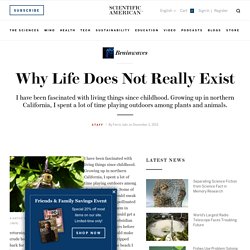
Growing up in northern California, I spent a lot of time playing outdoors among plants and animals. Some of my friends and I would sneak up on bees as they pollinated flowers and trap them in Ziploc bags so we could get a close look at their obsidian eyes and golden hairs before returning the insects to their daily routines. Sometimes I would make crude bows and arrows from bushes in my backyard, using stripped bark for string and leaves for fletchings. Shamanism. The earliest known depiction of a Siberian shaman, produced by the Dutch explorer Nicolaes Witsen, who authored an account of his travels among Samoyedic- and Tungusic-speaking peoples in 1692.
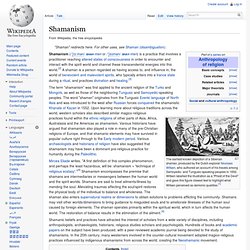
Witsen labelled the illustration as a "Priest of the Devil" and gave this figure clawed feet to highlight what Witsen perceived as demonic qualities.[1] Shamanism (/ˈʃɑːmən/ SHAH-mən or /ˈʃeɪmən/ SHAY-mən) is a practice that involves a practitioner reaching altered states of consciousness in order to encounter and interact with the spirit world and channel these transcendental energies into this world.[2] A shaman is a person regarded as having access to, and influence in, the world of benevolent and malevolent spirits, who typically enters into a trance state during a ritual, and practices divination and healing.[3] The term "shamanism" was first applied to the ancient religion of the Turks and Mongols, as well as those of the neighboring Tungusic and Samoyedic-speaking peoples.
Terminology[edit] Ascended master. Both "Mahatmas" and "Ascended Master" are terms used in the Ascended Master Teachings.
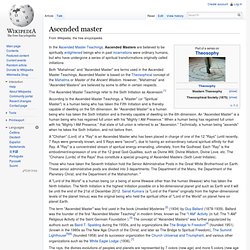
Ascended Master is based on the Theosophical concept of the Mahatma or Master of the Ancient Wisdom. However, "Mahatmas" and "Ascended Masters" are believed by some to differ in certain respects. The Ascended Master Teachings refer to the Sixth Initiation as Ascension.[1] Nadi (yoga) Chakra Kundalini Diagram Nāḍi (tube, pipe") are the channels through which, in traditional Indian medicine and spiritual science, the energies of the subtle body are said to flow.
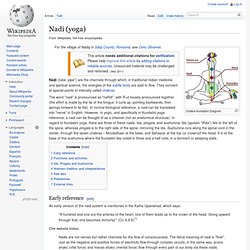
They connect at special points of intensity called chakras. Transcendental Meditation technique. The Transcendental Meditation technique is a specific form of mantra meditation[1] developed by Maharishi Mahesh Yogi.
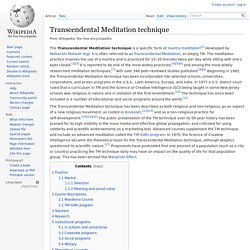
It is often referred to as Transcendental Meditation, or simply TM. The meditation practice involves the use of a mantra and is practiced for 15–20 minutes twice per day while sitting with one's eyes closed.[2][3] It is reported to be one of the most-widely practiced,[4][5][6] and among the most widely researched meditation techniques,[7] with over 340 peer-reviewed studies published.[8][9] Beginning in 1965, the Transcendental Meditation technique has been incorporated into selected schools, universities, corporations, and prison programs in the U.S.A., Latin America, Europe, and India. Akashic records. Background[edit] Akasha is a Sanskrit word meaning "sky", "space" or "aether", and it entered the language of theosophy through H.

P. Blavatsky, who characterized it as a sort of life force; she also referred to "indestructible tablets of the astral light" recording both the past and future of human thought and action, but she did not explicitly identify these as "akashic" in nature.[1] The notion of an akashic record is attributed to Alfred Percy Sinnett, who, in his book Esoteric Buddhism (1884), wrote of a Buddhist belief in "a permanency of records in the Akasa" and "the potential capacity of man to read the same. "[2][1] By C. List of New Age topics. Tao. Tao or Dao (/taʊ/, /daʊ/; Chinese: 道; pinyin: Dào ) is a Chinese concept signifying 'way', 'path', 'route', or sometimes more loosely, 'doctrine' or 'principle', or as a verb, speak.
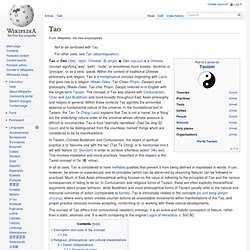
Within the context of traditional Chinese philosophy and religion, Tao is a metaphysical concept originating with Laozi that gave rise to a religion (Wade–Giles, Tao Chiao; Pinyin, Daojiao) and philosophy (Wade–Giles, Tao chia; Pinyin, Daojia) referred to in English with the single term Taoism. The concept of Tao was shared with Confucianism, Chán and Zen Buddhism and more broadly throughout East Asian philosophy and religion in general. Within these contexts Tao signifies the primordial essence or fundamental nature of the universe. Third eye. A Cambodian Shiva head showing a third eye.
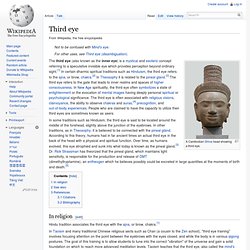
In some traditions such as Hinduism, the third eye is said to be located around the middle of the forehead, slightly above the junction of the eyebrows. In other traditions, as in Theosophy, it is believed to be connected with the pineal gland. According to this theory, humans had in far ancient times an actual third eye in the back of the head with a physical and spiritual function. Over time, as humans evolved, this eye atrophied and sunk into what today is known as the pineal gland.[3] Dr. Levitation (paranormal) A representation of a person levitating.

Various religions have claimed examples of levitation amongst their followers. This is generally used either as a demonstration of the validity or power of the religion,[5] or as evidence of the holiness or adherence to the religion of the particular levitator. In Hinduism, it is believed that some Hindu gurus who have become siddhas (those who have achieved spiritual powers) have the siddhi (power) of being able to levitate. Cosmic consciousness. Cosmic consciousness is a book published by Richard Maurice Bucke in 1901, in which he explores the phenomenon of Cosmic Consciousness, "a higher form of consciousness than that possessed by the ordinary man", a consciousness of "the life and order of the universe".
History[edit] In 1901 Canadian psychiatrist Richard Maurice Bucke published Cosmic Consciousness: A Study in the Evolution of the Human Mind, in which he explores the phenomenon of Cosmic Consciousness, "a higher form of consciousness than that possessed by the ordinary man", a consciousness of "the life and order of the universe". Bucke discerns three forms or grades of consciousness: Simple consciousness, possessed by both animals and mankind;Self-consciousness, possessed by mankind, encompassing thought, reason, and imagination;Cosmic consciousness, a consciousness of "the life and order of the universe", possessed by few man, but a next step of human evolution, to be reached by all in the future.
How to Meditate. Note: These instructions are drawn from the vipassana traditions of Mahasi Sayadaw and Chao Khun Bhavanapirama Thera.

It is assumed the reader is familiar with the article, What is Vipassana? Contents This article offers step-by-step instructions for nine insight meditation exercises, as well as a detailed explanation of mindful eating, hints on dealing with problems such as wandering mind, sleepiness, disturbing mental images, unpleasant emotions, and more. The following exercises are not necessarily listed in order of difficulty. Exercises suitable for beginners are noted. To start, choose one or two exercises and practice them daily. If there's something you don't understand at first, please don't let that daunt you.
100 Ways To Become More Conscious: How To Raise Your Consciousness. 1. Connect with nature – Go for a walk in the forest, jungle, field of daisies, or wherever you feel like getting a connection with nature. Self-Education. 5-Step Action Guide to Shine Your Light in 2010. 5-Step Action Guide to Shine Your Light in 2010 Have you ever wondered why it seems so easy for some people to make major changes in their life while others sit back as passive observers wondering what happened? They begin to wonder where their life went wrong. They say things such as, “Why are bad things always happening to me?” Levitation. 10 Steps for Transforming Negative Thoughts into Positive Beliefs. Critical Thinking Worksite: Introduction. I. Just What is Critical Thinking? When you hear "critical thinking", it is natural to think of criticism---that is, of unpleasant episodes involving your parents or your boss.
One can think critically in episodes like these, but the term applies to many others as well. Critical thinking is evaluative thinking---it involves evaluating options for the purpose of reaching conclusions about those options. Alongside writing and speaking, it is one of the most important intellectual skills you possess. What causes anxiety, obsession, jealousy, and depression in romantic relationships? What makes people anxious, fearful, and insecure? Spiritual Inquiry . com » 160 Zen stories. Outline of thought. Language and thought. Origin of language. The origin of language in the human species has been the topic of scholarly discussions for several centuries.
101 Timeless Lessons Life Teaches. Post written by: Angel Chernoff. Five Manifestos for the Creative Life. By Kirstin Butler. Self-organization. Cooperative. Jared Diamond on why societies collapse. Think Global. CHAOS - ORDER. THE MIND WORKINGS. Philosophy. Psyché. Philosophy. Philosophy tree. Consciosness. New age/spirituality. Awakening. Spirituality.
Personal Development. Self. SELF-IMPROVEMENT. Letting Go of Attachment. “Most of our troubles are due to our passionate desire for and attachment to things that we misapprehend as enduring entities.” ~Dalai Lama Editor’s note: This is a guest post from Lori Deschene of Tiny Buddha. If there’s one thing we all have in common it’s that we want to feel happy; and on the other side of that coin, we want to avoid hurting. Yet we consistently put ourselves in situations that set us up for pain. We pin our happiness to people, circumstances, and things and hold onto them for dear life. We attach to feelings as if they define us, and ironically, not just positive ones. In trying to hold on to what’s familiar, we limit our ability to experience joy in the present.
When you stop trying to grasp, own, and control the world around you, you give it the freedom to fulfill you without the power to destroy you. The Art of Loving Yourself. The Battle for Your Mind: Brainwashing Techniques Being Used On The Public By Dick Sutphen. Discovery - First Time Machine.
Robert Wright on optimism. Cosmopolitanism. Cosmopolitanism is the ideology that all human beings belong to a single community, based on a shared morality. Disinformation: Everything You Know Is Wrong. The Chubb Chubbs are coming! The 12th Planet written by Zecharia Sitchin (Audiobook) Astral Plane - A World Of Ethereal Being. As we enter the twenty-first century, with all its overwhelming confusion, stresses and disheartening material disappointments, it has come as no great surprise to learned people around the world that more and more people are looking inwards and turning to ancient spiritual practices with which to make order of their lives.
Learn How to Astral Project. Techniques for Beginners. Body Language. List of cognitive biases. List of thought processes. Cognitive distortion. Thinking.